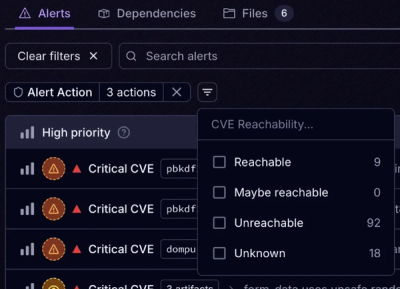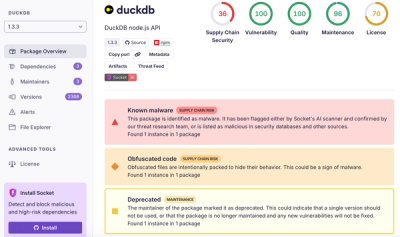
Product
Introducing Tier 1 Reachability: Precision CVE Triage for Enterprise Teams
Socket’s new Tier 1 Reachability filters out up to 80% of irrelevant CVEs, so security teams can focus on the vulnerabilities that matter.
travix-logger
Advanced tools
Logger library for the browser and node.js
Install it via npm:
$ npm install --save travix-logger
Example usage in ES6 (in node.js and webpack/browserify bundles):
import { Logger, configureConsoleTransport } from 'travix-logger';
const logger = new Logger({
transports: [
configureConsoleTransport()
]
});
logger.log('Error', 'EventName', 'Some error occurred', { meta: 'values' });
// same as
logger.error('EventName', 'Some error occurred', { meta: 'values' });
In the browser:
<script src="https://unpkg.com/travix-logger@latest/dist/travix-logger.min.js"></script>
<script>
// now available as `window.TravixLogger`
</script>
Levels are type of logs that you can capture with travix-logger. If you have a warn level, it will be made accessible to you from the Logger instance as logger.warn(event, message, meta) for example.
By default, these levels are used:
debugdebug(event, message, meta)
Level name: Debug.
infoinfo(event, message, meta)
Level name: Info.
warnwarn(event, message, meta)
Level name: Warning.
errorerror(event, message, meta)
Level name: Error.
exceptionexception(event, errorObject, message, meta)
Level name: Error.
You can override the levels data, at Logger instance level as follows:
import { Logger } from 'travix-logger';
const logger = new Logger({
levels: {
// key is the method name
error: {
name: 'Error' // the level name passed to formatters and transports
},
warn: {
// if `methodName` is not present, it will default to the key `warn`
},
exception: {
error: true // method then accepts `(event, errorObject, message, meta)`
}
}
});
Transports are responsible for storing the logs. Each instance of Logger can have multiple transports. For example, one Transport can be responsible for printing out the logs in console, while the other can sent it to a remote server.
This library already ships with a ConsoleTransport by default, which can be used right away:
import { Logger, configureConsoleTransport } from 'travix-logger';
const logger = new Logger({
transports: [
configureConsoleTransport()
]
});
Whenever you call logger.log() for example, the ConsoleTransport would take up the responsibility of printing out the log to console every time.
Creating custom transports is very easy, and the library already comes with the necesasry utilities for you:
// ./transports/MyCustomTransport.js
import { createTransport } from 'travix-logger';
export default createTransport({
initialize() {
// you have access to Logger instance as `this.logger`.
},
log(level, event, message, meta, cb) {
// do something with the data
console.log(level, event, message, meta);
// trigger the callback, when successful
cb(null);
// if any error while processing the log
cb(new Error('Something went wrong while processing the log'));
}
});
Now you can pass it as a Transport while instantiating a new Logger instance:
import { Logger } from 'travix-logger';
import MyCustomTransport from './transports/MyCustomTransport';
const logger = new Logger({
transports: [
MyCustomTransport
]
});
Formatters can intercept your log data, and modify them before they are sent to Transports.
They are just plain synchronous functions, which accept the same arguments as Logger.log(), and returns the modified values.
import { Logger } from 'travix-logger';
function myCustomFormatter(level, event, message, meta) {
meta.addedNewKey = 'some value';
if (meta.creditCardNumber) {
meta.creditCardNumber = mask(meta.creditCardNumber);
}
message += ' [appended message]';
return {
level,
event,
message,
meta
};
}
const logger = new Logger({
formatters: [
myCustomFormatter
]
});
levels(optional) Levels object, where level name is the key.
transportsArray of Transport classes.
formattersArray of Formatter functions.
defaultMeta(optional) Default meta object that logs' meta will extend from.
timestampDefaults to false. When true, it will add a new Date object to the timestamp key in meta object for every new logs.
If you want the timestamp in meta with a different key, you can pass a string instead.
errorMessageKeyFor mapping Error.message value in meta, when logging exceptions. Defaults to exceptionmessage.
errorStackKeyFor mapping Error.stack value in meta, when logging exceptions. Defaults to exceptiondetails.
optionsOptions passed during construction.
In addition to the methods listed below, Logger instances will also have methods according to the levels.
log
log(level, event, message, meta = {}, logCallback = null)
createTransport(options = {})
initializeinitialize()
Called when the Tranport class is constructed.
loglog(level, event, message, meta, cb)
This method must be implemented when creating a new Transport.
If there is any issue while processing the log, call cb(new Error('something went wrong')).
Otherwise, call cb(null);
nameCustom name for the Transport class, defaults to Transport.
Reference to the parent Logger instance.
each(arr, iterator, cb)
Utility function for processing an array asynchronously.
arr (Array): Array to iterateiterator (Function): Accepting these arguments:
item: The iterated item from the arraycb (Function): Call cb(null) when processed successfully, otherwise call cb(err).cb (Function): Called with null when all items processed successfully, otherwise with err.A configureable ConsoleTransport is shipped with the package:
import { Logger, configureConsoleTransport } from 'travix-logger';
const logger = new Logger({
transports: [
configureConsoleTransport({
// you can optionally override the `console` function
console: myAwesomeConsoleObject
})
]
});
consoleUnless any function is provided here, it will default to the global scope's console object. Like window.console in the browser.
filterOptional function that filters the logs from being processed. Defaults to returning true for all logs.
Example:
function filter(level, event, message, meta) {
return true;
}
formatOptional function that can customize log string in a console.
Example:
function format(level, event, message, meta) {
return `${level} - ${message}`;
}
nameDefaults to ConsoleTransport.
Transport for sending log data to a remote location:
import { Logger, configureHttpTransport } from 'travix-logger';
const logger = new Logger({
transports: [
configureHttpTransport({
// required
url: 'https://logs.example.com/submit',
// optional
method: 'POST',
formatBody(level, event, message, meta) {
return JSON.stringify({
level,
message,
...meta
});
}
})
]
})
urlURL to send the log data to.
filterOptional function that filters the logs from being processed. Defaults to returning true for all logs.
Example:
function filter(level, event, message, meta) {
return true;
}
methodOne of the HTTP methods, defaults to POST.
GET and HEAD are not allowed, since they do not support body.
nameDefaults to HttpTransport.
eventKeyFor mapping the event name in the body. Defaults to messagetype.
formatBodyA function accepting (level, message, meta), and returning a string to be used as body value.
headersFollows fetch API. Currently defaults to:
{
'Accept': 'application/json',
'Content-Type': 'application/json'
}
Supports:
credentialsmodecacheredirectreferrerreferrerPolicyintegritySee Fetch API documentation.
To release a new version:
$ make release VERSION=patch
VERSION value can be patch, minor, or major following semver.
MIT © Travix International
FAQs
Logger library for the browser and node.js
We found that travix-logger demonstrated a not healthy version release cadence and project activity because the last version was released a year ago. It has 9 open source maintainers collaborating on the project.
Did you know?

Socket for GitHub automatically highlights issues in each pull request and monitors the health of all your open source dependencies. Discover the contents of your packages and block harmful activity before you install or update your dependencies.

Product
Socket’s new Tier 1 Reachability filters out up to 80% of irrelevant CVEs, so security teams can focus on the vulnerabilities that matter.

Research
/Security News
Ongoing npm supply chain attack spreads to DuckDB: multiple packages compromised with the same wallet-drainer malware.

Security News
The MCP Steering Committee has launched the official MCP Registry in preview, a central hub for discovering and publishing MCP servers.